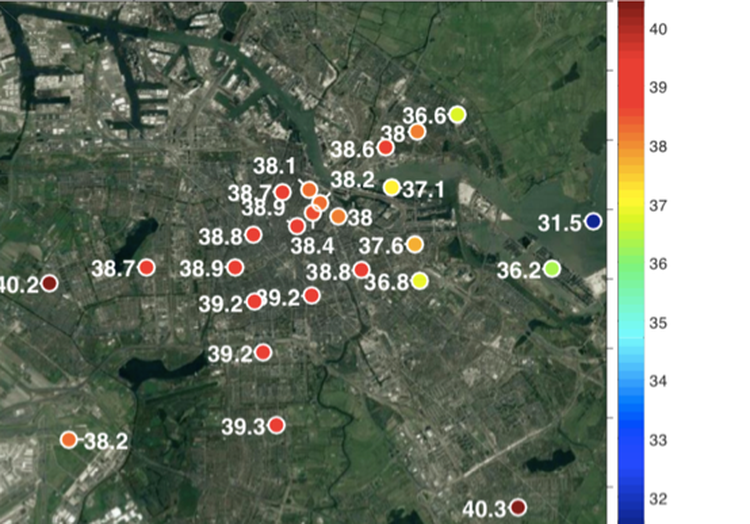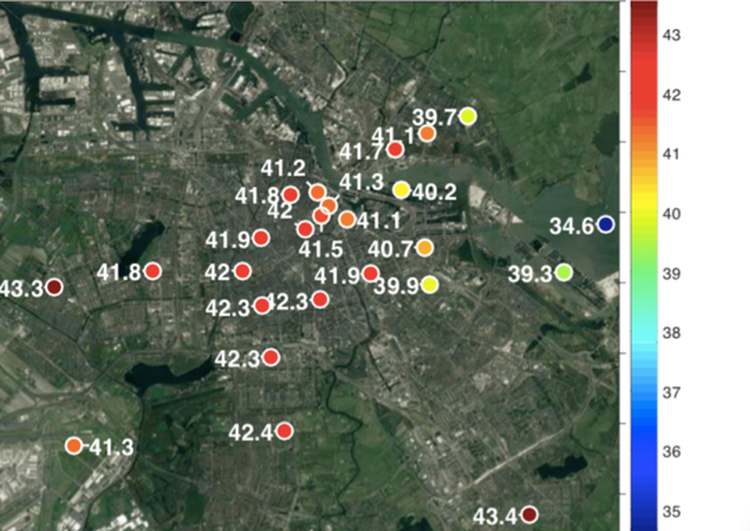The full read of the Climate Adaptation Strategy of the Municipality of Amsterdam can be downloaded here (download only available in Dutch).
The impact of heat in cities
The summer of 2018 was extremely hot and dry, and also in the summer of 2019 we experienced two big heat waves in the Netherlands. For Amsterdam, as for many other cities, this resulted in a higher energy consumption, declined water quality, malfunctioning bridges, dying plants and grass, subsiding housing foundations and cracked cycle paths and roads. The extreme temperatures not only affected the environment, but also human health and well-being, especially of elderly people and young children. According to the Royal Netherlands Meteorological Institute (KNMI), the kind of heat waves we saw last year, will become more frequent: from once every twenty years a century ago, to every two to three years now.
Due to increasing urbanisation the number of people having to deal with the consequences of increasing heat is also growing. In densely populated areas such as Amsterdam, heat waves are more extreme, as a result of the so-called 'urban heat island effect'. This means that heat generated by people, vehicles and the sun is easily trapped by the materials used to build houses, industrial buildings, sidewalks, and parking lots. The temperature difference with areas outside the city can sometimes exceed more than five degrees. The effect is strongest at night during calm, clear weather. The intensity of the urban heat effect strongly depends on the density and height of the buildings and on the amount of green spaces present.
Researching urban heat
During last July's heatwave, researchers from Wageningen University & Research and Amsterdam Institute for Metropolitan Solutions (AMS Institute) launched weather balloons from Dam Square to map the height of the urban dome. The aim was to find the cross-over point, the altitude in the atmosphere where the city's heat is no longer noticeable, and the temperature is equal to the temperature of the rural area.
In order to map the difference between city and countryside, measurements were also made in a rural area 22km outside of Amsterdam. The results of the measurements showed that in the evening the heat of the city impacted temperatures up to a height of 120 meters (about 50 stories high). Also, in the evening it remained 3.4 degrees warmer in the city than the countryside. In to map heat differences within the city, the observations of 24 weather stations located in the city have been added to the analysis.
Future scenarios for heat in the city
The Royal Netherlands Meteorological Institute developed four climate scenarios that provide guidelines for calculating the consequences of climate change and develop options and strategies for climate adaptation.
The climate scenarios are the four combinations of two different values for global temperature rise, 'Moderate (1 ºC)' and 'High (2 ºC)', and the possible changes in air flow patterns. 'Low' for no to limited change and 'High' for more change (which would mean more wind from the east, which is warmer wind than the wind that comes from the west). Together they describe the vertices at which climate change is likely to occur in the Netherlands (according to the latest insights of the Royal Netherlands Meteorological Institute).
Extrapolating the temperatures of the AAMS weather station network measured during the heatwave of July 2019, this would show the following scenario for heatwaves in the year 2085:

Projected daytime maximum temperatures for heatwaves in 2085 based on the moderate/low climate scenario of the Royal Netherlands Meteorological Institute.

Projected daytime maximum temperatures for heatwaves in 2085 based on the warm/high climate scenario of the Royal Netherlands Meteorological Institute.
The data used for these projections are based on the temperatures measured by the AAMS network during the heatwave in the summer of 2019. The 2085 projection shows a staggering average of 42 degrees throughout the city, however, this is not an unlikely scenario for future periods of heat.
“It is often underestimated how much impact heat stress has on, for example, the vitality and productivity of inhabitants. Understanding the urban climate and the predictability of a city's weather profile is therefore becoming increasingly important”
Gerben Mol
Program Developer
Creating climate resilient cities
To create climate resilient cities a climate adaptation planning approach should be in place. The Climate Resilient Cities research program of AMS Institute evaluates the functioning, adaptation and resilience of climate systems. The entire urban air-water-soil-green system is analyzed, to map rainfall, temperature and wind turbulence in and around Amsterdam. We use this information to create a climate adaptation planning approach that carefully designs and assesses interventions such as greening and the sustainable (re)design and maintenance of the city’s infrastructure. More information about our Climate Resilient Cities Program can be found here.
